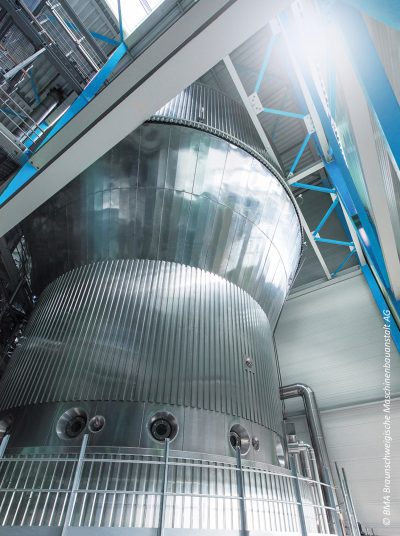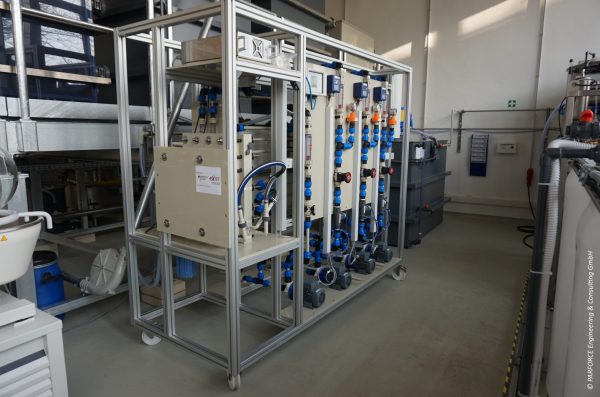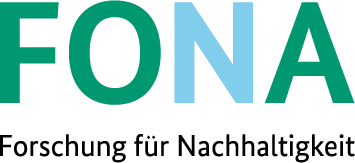
Coordination
CUTEC-Forschungszentrum der TU Clausthal
Leibnizstraße 23
38678 Clausthal-Zellerfeld
Project management
Prof. Dr.-Ing. Michael Sievers
Tel. +49 5323 72-6243
michael.sievers@cutec.de
Partner institutions
- Abteilung Abwasserverfahrenstechnik – CUTEC
- Abteilung Thermische Prozesstechnik – CUTEC
- Abteilung Ressourcentechnik und -systeme – CUTEC
- PARFORCE Engineering & Consulting GmbH
- Lukson AG
- Knoke Industrie-Montagen GmbH
- Stadt Northeim mit Eigenbetrieb Abwasserbeseitigung
Associated partners
- Braunschweigische Maschinenbauanstalt AG
- Schwenk Zement KG (Werk Bernburg)
- HeidelbergCement AG
Funding period
01.10.2020 – 30.09.2023 (Phase 1)
Webseite
Projekt sheet
KlimaPhoNds
Climate-neutral and residue-free sewage sludge utilization with phosphoric acid production in the southeast of Niedersachsen
Abstract
KlimaPhoNds pursues a decentralized phosphate extraction in wastewater treatment plants, and based on this, a centralized refinement of the phosphate precipitation products to high-quality phosphoric acid, ammonia water and magnesium chloride. The climate neutrality is achieved by a nearly heat-neutral drying process with fluidized bed evaporation drying. The result is a fully dried, low-phosphate sewage sludge that can be recycled without residue and used in the cement industry for material and energy generation. A prerequisite for enough P-depletion in the sewage sludge is an optimized bio-P-elimination at the sewage treatment plant. In the first of two phases, the bio-P elimination at the Northeim wastewater treatment plant is maximized. If enough Bio-P fixation is successfully demonstrated, phase 2 will demonstrate the processing of the precipitation products to different raw materials, the almost heat-neutral drying and the utilization of dry sewage sludge as fuel and raw material on a technical scale.

Example of a fluidized-bed evaporation dryer adapted to sewage sludge. © BMA Braunschweigische Maschinenbauanstalt AG
Aim
Essential aims of KlimaPhoNds are the technical and economic proof of a) a phosphorus recovery in compliance with legal requirements b) a multiple resource efficiency on the way towards a zero emission sewage sludge recycling, c) required product qualities for the recycling of phosphoric acid, ammonia water and magnesium chloride.

Parforce pilot plant to produce high-quality phosphoric acid. © PARFORCE Engineering & Consulting GmbH
Fokus of work
- Reconstruction of the wastewater treatment plant to maximize bio-P elimination with proof that the dewatered sludge falls below 20gP/kgTS (TRL9)
- Process optimization to maximize the yield of phosphate recovery
- Planning, construction and operation of the large-scale phosphate extraction plant (TRL9)
- Treatment of phosphate precipitation products to phosphoric acid, ammonia water and magnesium chloride on a ton scale (TRL8)
- Technical testing of internal material cycles (TRL8)
- Development and operation of a large-scale fluidized bed evaporation dryer (TRL8) at the sewage treatment plant.
- Utilization of the fully dried and low phosphorus sewage sludge in the cement industry (TRL9).
- Evaluation of the overall concept (technical, ecological and economic)
Work Packages
Contact
Prof. Dr.-Ing. Michael Sievers, Department of Wastewater Process Engineering – CUTEC,
Leibnizstraße 23, 38678 Clausthal-Zellerfeld, michael.sievers@cutec.de
Abstract
The tasks include coordination of communication and information of all project partners; coordination and monitoring of the project progress; representation of the project network in public and explanation of the project goals and project progress; communication and presentation of the new technologies at conferences, trade fairs, on the Internet etc.; organization of joint project meetings.
Contact
René Schumann, Department of Wastewater Process Engineering – CUTEC,
Leibnizstraße 23, 38678 Clausthal-Zellerfeld, rene.schumann@cutec.de
Olaf Hagenow, Owner of waste water disposal of the city of Northeim (EBA),
Scharnhorstplatz 1, 37154 Northeim, hagenow@northeim.de
Project partners
EBA Northeim; Waste water process engineering department – CUTEC; Knoke Industrie-Montagen GmbH
Abstract
At the start of the project, conversion work will be carried out at the Northeim wastewater treatment plant to maximize the Bio-P capacity. The aim is to improve the Bio-P capacity and the P-release for a legally enough P-depletion in the dewatered sewage sludge. Parallel to this, investigations for the optimization of phosphate precipitation and separation as well as planning work for the technical P-recovery plant are being carried out. After installation and commissioning, several test phases are carried out to determine reliable operating data. Based on the evaluated measurement data, it is to be proven that a) the increased MAP separation works on a fully technical scale and b) the legally required limit value of 20 gP/kgTS in the dewatered sewage sludge can be safely met.
Contact
Andreas Knecht, Knoke-Industrie-Montagen GmbH,
Gesellensteig 48, 38229 Salzgitter, knecht@knoke-salzgitter.de
Adam Bardosi, Knoke-Industrie-Montagen GmbH,
Gesellensteig 48, 38229 Salzgitter, bardosi@knoke-salzgitter.de
Prof. Dr.-Ing. Michael Sievers, Department of Wastewater Process Engineering – CUTEC,
Leibnizstraße 23, 38678 Clausthal-Zellerfeld, michael.sievers@cutec.de
Projekt partners
Knoke Industrie-Montagen GmbH; EBA Northeim; Department of Wastewater Process Engineering – CUTEC
assoziierter Partner: BMA
Abstract
Sewage sludge drying is implemented as almost heat-neutral drying by means of fluidized bed evaporation drying. This technology has not been used for sewage sludge so far, which is why further developments are planned. The work focuses on (a) design/construction of the plant components and periphery, (b) functional testing of the individual components, (c) conceptual design and development of the EMSR technology and (d) production of the pilot dryer. In addition, flexible heat utilization concepts for the Northeim wastewater treatment plant are developed and described. The pilot dryer will be installed on an industrial scale at the wastewater treatment plant. This is followed by testing, validation and optimization of the drying plant technology.
Contact
Dr.-Ing. Stefan Vodegel, Department Thermal Process Engineering – CUTEC,
Leibnizstraße 23, 38678 Clausthal-Zellerfeld, stefan.vodegel@cutec.de
Projekt partners
Department Thermal Process Engineering – CUTEC; Department Wastewater Process Engineering – CUTEC
PARFORCE Engineering & Consulting GmbH; Lukson AG
Abstract
The refinement process involves a virtually residue-free conversion of magnesium ammonium phosphate (MAP) to phosphoric acid, ammonia water and magnesium chloride. For this purpose, calcination and the par force technique are used. The existing processes are to be optimized from an economic point of view, the increase of the product yield and product purity as well as the reduction of the chemical demand based on process-technical conditions and process engineering correlations. The results will be used for the conceptual design of a model plant, which qualitatively exceeds the current state of the art. The calcination including gas cleaning and treatment will be planned in detail according to §15 of the HOAI. A part of the MAP obtained will be further processed on a ton scale to phosphoric acid and magnesium chloride after previous calcination and ammonia water separation using the Parforce pilot plant. Product approvals are also being reviewed/applied for and potential sales markets for main and by-products of MAP refining are being developed.
Contact
Dipl.-Ing. Franz Hormes, Lukson AG, Geyener Straße 1, 50259 Pulheim, f.hormes@lukson.de
Projekt partners
Lukson AG; Department Thermal Process Engineering – CUTEC; Department Wastewater Process Engineering – CUTEC; EBA Northeim; Assoziierte Partner: HeidelbergCement AG, Schwenk Zement KG (Werk Bernburg)
Abstract
A residue-free utilization of the dried, low-phosphorus sewage sludge from the Northeim sewage treatment plant is being investigated. The utilization can be materially and energetically in the cement industry or purely energetically in the energy industry. The individual material flows, and the respective benefits are to be determined and evaluated ecologically and economically based on practical data. The concept of sewage sludge mono-combustion is also to be investigated and evaluated.
Contact
Technische Bewertung: Prof. Dr.-Ing. Michael Sievers, Department of Wastewater Process Engineering – CUTEC,
Leibnizstraße 23, 38678 Clausthal-Zellerfeld, michael.sievers@cutec.de
Ökologische Bewertung: Jan Schlecht, Department of Resource Engineering and Systems – CUTEC,
Leibnizstraße 23, 38678 Clausthal-Zellerfeld, jan.schlecht@cutec.de
Wirtschaftliche Bewertung: Dr.-Ing. Stefan Vodegel, Department Thermal Process Technology – CUTEC,
Leibnizstraße 23, 38678 Clausthal-Zellerfeld, stefan.vodegel@cutec.de
Projekt partners
The concept evaluation is a joint task of all project partners.
Abstract
The evaluation of the entire process concept (sustainability assessment) covers three areas: 1. decentralized phosphorus extraction 2. central MAP refinement, 3. material and thermal utilization possibilities of the sewage sludge with heat-neutral drying. For the sustainability assessment, a balance model of the material and energy flows of the process concept is also created and supported with practical data from technical tests. In addition, technical and economic evaluations of all partners involved are developed and consolidated under the leadership of CUTEC.
Ways of exploitation
The following main and by-products are produced: High-quality phosphoric acid, which is used directly in the chemical industry, e.g. for fertilizer production without further processing. Fully dried and low-phosphate sewage sludge as fuel and aggregate in the cement industry, alternatively in the energy industry. Ammonia water as a product for denitrification of exhaust gases from incineration plants or as a replacement for the nitrogen source produced by the Haber-Bosch process for nutrient production. Magnesium chloride solution as phosphate precipitant with a magnesium cycle between the sewage treatment plant and the phosphoric acid production plant.

